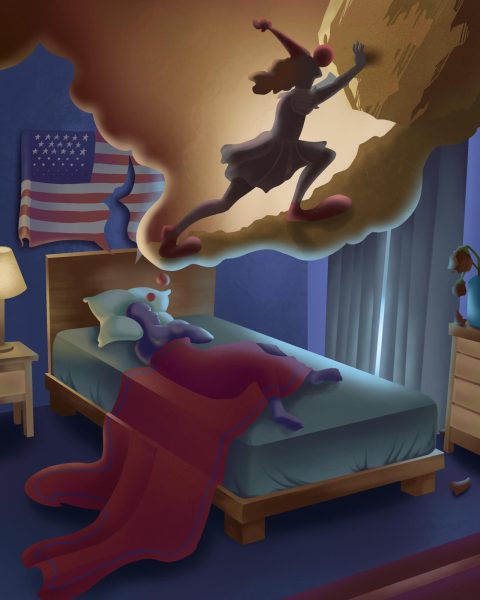Not so happy endings
The evolution of sexually transmitted diseases
Imagine living with a disease that can make you a social pariah. It can cause people to fear your touch and your presence. This is the reality HIV-positive Sean McGregor, 18, has faced for the past two years. “I’ve had people who knew I was HIV-positive refuse to shake hands with me,” McGregor said. “I’ve had people tell me ‘don’t breathe on me’ as if HIV is like the common cold virus that travels through the air. Obviously they don’t know how the disease is transmitted, and that’s really scary.”
McGregor said people need to learn that they cannot contract the virus by simply touching or breathing near someone who is HIV-positive. “You can’t get it from breathing the same air as someone who has it, you can’t even get it from kissing someone who has it. The only way you can get it is by sharing bodily fluids—such as semen or blood—with someone who has it.”
McGregor and his partner David Lowel, 18, experience the stigma that comes along with having HIV every day, and they seek to educate people about how to keep themselves from getting an STD when their partner has one. “I’ve been openly gay since I was 13,” Lowel said. “Luckily for me, I have a great support system. My parents and friends love me for me, but my partner Sean wasn’t so lucky. His parents tolerated his ‘choice’ of lifestyle for a while, up until he got HIV.”
Lowel and McGregor met in high school. Lowel was already out at the time but McGregor was not out to anyone except his parents who always made their disdain for his sexuality known. “It was confusing, before I came out to my mom and dad, I used to have a fake I.D. and get into these gay bars,” said McGregor. “I’d meet skeezy guys there and hook up with them. I knew that if I were gay, this wasn’t the right way to do it. Having sex with guys I’d only known for a night wasn’t safe, but I felt like it was the only way I could escape. I could be myself there.” When McGregor finally came out to his parents they thought a change in location might “cure” him, so they moved from Alabama to California. That’s where the two boys met.
McGregor said Lowel was someone everyone always wanted to be around; he was the kid in the hallway who was always goofing off with different cliques and everyone seemed to like him. It was like the rules of the high school social hierarchy didn’t apply, and everyone was drawn to him like a magnet. No one seemed to care that he was gay and it gave McGregor hope that he too could be accepted here.
By the time the two met, McGregor said he knew he was HIV-positive.
“My parents had kicked me out,” McGregor said. “I slept in my car. I was really just keeping to myself.” Despite the hardship, McGregor couldn’t resist when Lowel asked to go see his favorite movie at a classic theater.
“We’ve been together for a little over a year now; I love him to death, and Sean is HIV-positive and we’re very proud to say that I am still not.” Lowel said the key to remaining HIV-negative is their combined use of condoms and getting regularly tested. “Getting tested is important too, especially if you have a new sexual partner, a partner whom you suspect may be infected or a partner that you know is infected.” Lowel and McGregor hope that their story will help end the stigma around HIV and other STDs. They want everyone to know it is possible to have a safe sexual relationship with someone who has an incurable STD.
AIDS was first reported on June 5, 1981 in Los Angeles, Calif. according to aids.gov. This initial report, which included five gay, previously healthy men who said that they had a rare lung infection and other symptoms that indicated their immune systems were not working properly, would spark the AIDS crisis of the 1980s. AIDS is the final stage of the HIV infection, but according to The AIDS Institute, the two diseases were not differentiated until 1983. When the diseases were first discovered it was thought that they were exclusive to the gay community and commonly called GRID, Gay-Related Autoimmune Deficiency. Being diagnosed with HIV or AIDS was essentially believed to be a death sentence at the time due to lack of understanding and treatment. Today, however, these sentiments have been proven untrue.
Aids.gov estimates that 1.1 million people currently living in the United States are living with HIV, and 15.8 percent are unaware of it.
Although HIV and AIDS affect homosexual Caucasian men the most, accounting for 63 percent of all new infections in 2010, HIV and AIDS are no longer issues limited to the LGBT community. Since the epidemic began, an estimated 85,000 people who contracted HIV through heterosexual contact have died from AIDS.
In recent years, the treatments for HIV and AIDS have been greatly improved. The Center for Disease Control reports that deaths due to HIV and AIDS are currently at a historic low, with a little over 10,000 deaths last year due to the diseases compared to the peak of HIV- and AIDS-related deaths in 1994, which included over 50,000 people. The CDC attributes the drop in the HIV and AIDS mortality rate to the introduction of antiretroviral treatment, or ART. Aids.gov reports that although antiretroviral treatments do not cure HIV and AIDS, they do help control the amount of the virus within a patient’s body and protect the patient’s immune system. According to international AIDS and HIV charity AVERT, infected patients will generally take three different ARTs, and taking these drugs has proven to drastically increase the lifespan of someone afflicted with HIV or AIDS. While ART does not entirely eliminate the possibility of passing HIV or AIDS to someone else, it does reduce the risk. The CDC reports that antiretroviral treatment coupled with the use of a barrier, such as condoms, during intercourse reduces the risk of transmission from one partner to another by about 92 percent.
Dr. Michael Albertson, a gastroenterologist at UCLA, was practicing medicine at the height of the AIDS epidemic in Los Angeles. He watched people die within weeks to months of their diagnosis. There was an entire floor at Sherman Oaks Community Hospital dedicated to AIDS patients. “All we could do back then was offer supportive care as there was no specific anti-viral therapy available,” Albertson said.
But things have changed drastically.
“I have patients who have been living with the HIV virus for 25 years who remain asymptomatic as long as they take their medication,” Albertson said.
Another way people are avoiding transmission of HIV is through the use of Pre-Exposure Prophylaxis, or PrEP. According to the CDC, “The pill (brand name Truvada) contains two medicines (tenofovir and emtricitabine) that are used in combination with other medicines to treat HIV. When someone is exposed to HIV through sex or injection drug use, these medicines can work to keep the virus from establishing a permanent infection.” The CDC also found that when taken consistently, PrEP is 92 percent effective in preventing the spread of HIV from one person to another.
Although HIV and AIDS infections are on the decline, young people are being infected with other STDs, such as chlamydia, gonorrhea, and syphilis at historic rates. According to the CDC, sexually active young people between the ages 14 and 25 account for 50 percent of all STD cases, and one in four of these individuals currently has an STD.

Elizabeth Santana*, 23, said she contracted gonorrhea from a boyfriend. Santana said she went to her doctor in March 2011 to get some antibiotics for a cold. Inside the doctor’s office, Santana told the doctor about the cold symptoms she was experiencing. She added that she was also experiencing itching in her genitals and that it hurt when she went to the bathroom. The doctor then asked if she was having any unusual bleeding between periods. She was.
Santana told the doctor she thought the symptoms were related to her cold, but the he assured her the symptoms were more consistent with an STD. He proceeded to ask if she was sexually active. Elizabeth said she was dumbfounded and that an STD wasn’t “even on her radar.” Santana confirmed that she was sexually active and told him, “I’ve only ever been with one guy.”
The doctor advised that she be tested for STDs. While he went to get a cup for her urine test, Santana sat quietly, unable to absorb the thoughts that swirled in her consciousness. Santana said that it was strange taking the test. “It was like an out-of-body experience, you know? I was there but it was like I wasn’t there,” she said. She said nothing to her boyfriend of five years about what had occurred at the doctor’s office.
“I was looking for signs of something in his behavior that maybe I’d missed before,” Santana said, “but there was nothing. He was his usual sweet self. It was rainy that weekend, so we spent it inside, cuddling on the couch watching Netflix—one of our favorite rainy day activities.” By the end of the weekend Santana said there was no doubt in her mind that her boyfriend had not infected her with an STD. Unfortunately she would find out the next day that she was wrong. When the doctor called her that Monday, he bluntly told her that she had Gonorrhea.
Santana said she grabbed the keys to her car, and drove the 15 miles to her boyfriend’s house. He answered the door and she told him outright. It was when his face crumpled that she knew the truth. “[I yelled] ‘You were the first person I’d ever had sex with and now I have an STD.” She said she felt like hitting him in the face and crawling into a deep, dark hole where she could escape the humiliation of being a statistic. Her boyfriend’s response was that it had been a “one time thing,” and that “it didn’t mean anything.” Santana said she ended the relationship and began the necessary treatment to cure her gonorrhea. “I was treated and I am now STD free. But there are a lot of people in my same situation that got an STD through no fault of their own, and theirs isn’t curable, or it can even be fatal. So in that respect, I was very lucky.”
Santana is correct that she is not alone. The CDC reports that the United States has the highest prevalence of STDs among its youth compared to any other country in the world, and the rate at which young people are being infected is still rising every year. Dr. Cullins, a board certified obstetrician and Vice President for Medical Affairs at Planned Parenthood said that while it’s important to remember there is no such thing as completely fool proof safe sex, there are ways to have safer sex. Condoms are one of the most effective methods for both STD protection and birth control. Cullins encourages people to take control over their sex lives and use a condom every single time. Cullins also said that if you have a sexual encounter with someone that you are not in a committed relationship with, you should get tested for some of the most common STDs. There are 20 million new STD cases every year in the United States, adding to the estimated 110 million cases in the country in total. The most common STDs among young people are Gonorrhea, Chlamydia, and Human Papilloma Virus, all of which, according to Cullins, can be prevented by using a condom.
Although condoms help prevent STDs, the threat of drug resistant viruses and bacteria is continually growing in the world today. One in particular is that of antibiotic-resistant Gonorrhea. An April 4 study released by the CDC reported that Gonorrhea is now resistant to Ciprofloxacin, an antiobiotic, and that Cephalosporin injections are the only current method of treatment. The report states, “Ciprofloxacin resistance was associated with increases in Gonorrhea incidence rates during the late 1990s and 2000s despite availability of other well-studied recommended treatment options. Correspondingly, emerging Cephalosporin resistance could have even more substantial health and economic consequences, particularly as the number of available treatment options decreases.”
According to AIDS Chicago, an AIDS awareness foundation based out of Chicago, Illinois, in a study of 123 discordant couples who used condoms every time they had sex, none of the uninfected partners contracted a disease. However, among 122 couples who used condoms inconsistently, 12 partners became infected, suggesting that the risk of passing an STD to an uninfected person is higher among those who do not use protection.
Rich Yap, 26, has experienced this type of STD transmission first hand. Yap was a self-described promiscuous person, but he often used condoms before he was infected.
“I had Chlamydia,” Yap said, “I was 25 and it was my first STD ever. For me it wasn’t so much of a shock because of the lifestyle I was living at the time. It was just more like ‘okay how can I get treated?’ And Chlamydia is very treatable. You just take an antibiotic and that’s it.”
The antibiotic Yap described is Azithromycin, which is a popular treatment for curing both Chlamydia and Gonorrhea. Often, when someone who does not use protection regularly has their first bout with an STD, it serves as a wake-up call as to the dangers of having unprotected sex.
“I was very proud of my track record of never having an STD,” Yap said, “but it just made me realize that no one is immune. I’m definitely a lot safer now, and I use protection.”
Herpes is one of the three aforementioned STDs that are currently on the rise among youth. According to the CDC, it is caused by the Herpes Simplex Virus and about 17 percent of people between the ages of 14 and 49 are infected. The reports cites having unprotected vaginal, anal and/or oral sex as a common way of contracting the virus. Herpes is currently incurable; however, there are treatments that can shorten and control the severity of outbreaks. Using latex condoms every time you have sex will reduce the risk of passing Herpes to your partner.
It goes without saying that there is a societal stigma regarding the contraction of any STD, and according to AVERT there are 25 different types of STDs, including the three most common mentioned in this article. Those infected are faced with shame, embarrassment and judgment, such as what Sean McGregor experienced. As a result, many STDs go unreported and untreated, and because of this, the exact numbers of people affected by STDs every year cannot be known.
“We’re all human,” Yap said.
“Just because you have an STD, it doesn’t mean you’re unclean or anything. It just means that you’re having sex. It happens. And you shouldn’t be ashamed.”
Header photo by Denisse Duran and Damian Jimenez.
* Elizabeth Santana’s name was changed to protect her identity.
Substance is a publication of the Mt. San Antonio College Journalism Program. The program recently moved its newsroom over to Medium as part of a one-year experiment. Read about it here: https://medium.com/substance/the-experiment-be947b2ba13e







